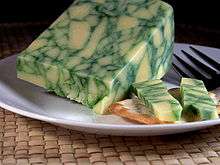Sage Derby
Sage Derby /ˈdɑːrbi/ is a variety of Derby cheese that is mild, mottled green and semi-hard, and has a sage flavour.[1][2][3] The colour is from sage and sometimes other colouring added to the curds, producing a marbling effect and a subtle herb flavour.[4] The colour is formed either by mixing sage leaves into the curd before it is pressed or by the addition of "green curd" from green corn or spinach juice. In the latter case, the flavour has to be created with colourless sage extract. Parsley, spinach and marigold leaves, bruised and steeped before use, can also be included instead of the sage leaves.[5] It is aged for one to three months.[4]
| Sage Derby | |
|---|---|
 | |
| Country of origin | England |
| Region | East Midlands |
| Town | Derby |
| Source of milk | Cows |
| Texture | semi-hard |
| Fat content | 45% |
| Aging time | 1-3 months |
History
The first production began in the seventeenth century in England. Sage Derby was initially only made for festive occasions such as harvest time and Christmas, but it is now available all year.
References

|title=(help)
- "Sage Derby". British Cheese Board. Retrieved 4 August 2017.
- "Sage Derby". cheese.com. Retrieved 1 August 2017.
- "Maffra Sage Derby". cheese.com. Retrieved 1 August 2017.
- Harbutt, Juliet (1999). Cheese. p. 170. ISBN 9781572232006.
-
Ward, Artemas (1911). The Grocer's Encyclopedia. p. 123.
SAGE CHEESE: is made by the Cheddar process and in many shapes and sizes. Its distinguishing characteristic is the flavor of sage and its green mottled appearance when cut. The color is obtained either by mixing green sage leaves in the curd before pressing, or by the addition to the main curd of "green curd" obtained by the aid of the juice of green corn—in the latter case, the sage flavor being obtained by the use of sage extract. Parsley, spinach and marigold leaves, bruised and seeped before use, are sometimes employed in place of sage leaves